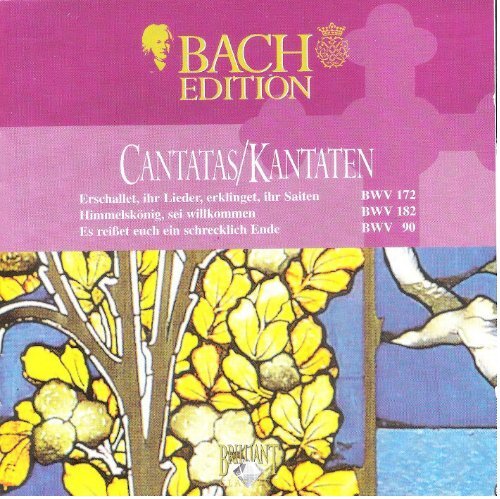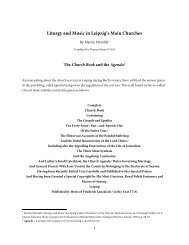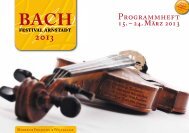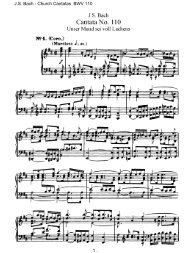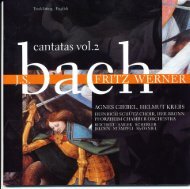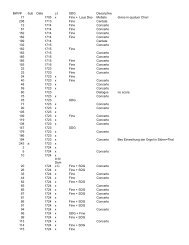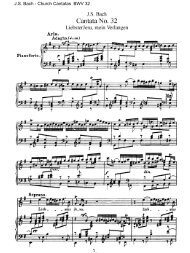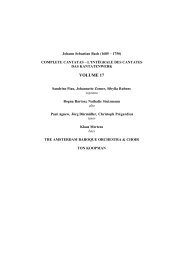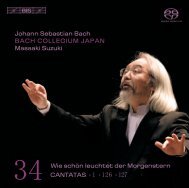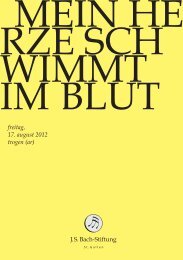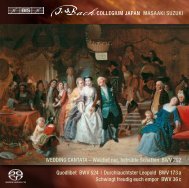Bach Cantatas, Vol. 3 - P.J. Leusink (Brilliant Classics 5-CD)
Bach Cantatas, Vol. 3 - P.J. Leusink (Brilliant Classics 5-CD)
Bach Cantatas, Vol. 3 - P.J. Leusink (Brilliant Classics 5-CD)
You also want an ePaper? Increase the reach of your titles
YUMPU automatically turns print PDFs into web optimized ePapers that Google loves.
JOHANNSEBASTIAN BACH<br />
CANTATASBWV 172-182 &90<br />
The PentecostCantata 172 'Erschallet, ihr Lieder' isa fineexample of theeconomical and painstaking mannerin<br />
which <strong>Bach</strong> bOlTOwedhis own music.This is oneof the cantatas composed after his appointment asconcertmaster<br />
in Weimar,with the obligation to produce a church composition every month.The work dates from 20 May 1714;<br />
<strong>Bach</strong> wasto repeat it several times in Leipzig, though in a somewhatmore extensive form in whichthe opening<br />
chorus was repeated at the end, as an extra seventhmovement after the original final chorale. Moreover,the entire<br />
work was trdDsposedfrom C major 10D major.The mdianl and dance-like opening chorus to the text 'Erschallet, ihr<br />
Lieder' is reinforcedby three trumpets(andtimpani), seeming tocompete with the strings.The moodof lhe music<br />
reminds oneof the openingof the ChristmasOratorio. Inthe more subdued middle sectionthe trumpets are silent,<br />
only to claim a leadingroleonce morein the bass aria 'Heiligste Dreieinigkeit', wheretheir triadpatterns symbolise<br />
the Holy Trinity. Interms ofdynamics the succeeding tenor aria is morc modest; it isreally a menuet for a trio<br />
consisting of tenor,high stringsand bassocontinuo. In the following duet (no. 5). a chorale-based movement, we hear<br />
a dialogue between the soul (soprano)and theholy spirit(alto), while the oboe and organ performan ornamented<br />
version of the chorale melody.<br />
Cantata 182 'Himmelskonig, sei willkommen' dates from approximately thesame period. It waswritten for Palm<br />
Sunday 25 March 1714,and <strong>Bach</strong> repeated it at least twice in Leipzig in 1724and 1728.In viewof the text it is<br />
understandable that <strong>Bach</strong> usedthe work in Leipzig on the feast of theAnnunciation of the BlessedVirginMary (25<br />
March); indeed, in 1714Palm Sunday and the Annonciationfell on the same day. Inthe dignified opening movement<br />
(Sonata)the 'king of heaven' is welcomed by recorders, solo violinand plucked(later bowed) strings.The cantata<br />
boasts no less thanthree choral movements:one after the Sonata, andtwo toconclude the work. Inbetween arc three<br />
arias: one for the bass, a wonderfully expressivemovementfor the alto, and a calmand sometimes richly ornamented<br />
aria for the tenor.<br />
In Cantata 90 'Es reisset euch ein schrecklich Ende' the role of the choir is limited to the final chorale, the other<br />
movements being solos (recitatives and arias) for the tenor, alto, bass, and again tenor. The work was wrinen for the<br />
25th Sunday after Trinity (14 November 1723). Apart from the high solo trumpet part in the third movement the<br />
instrumentation is uncertain. <strong>Bach</strong> probably had a string ensemble in mind, strengthened byan oboe and supported<br />
by the continuo. The lext refers to the Day ofJudgement, illustrated bythe somewhat threatening embellishments in<br />
the solo violin part and thetrumpet warnings inthe third movement.<br />
Clemen.r Romijn<br />
2
JOHAI\-;~SEBASTIA.'\BACH<br />
CA1\JTATAS B\\'\' 106-199& 161<br />
Cantata 106 Gottes Zeil ist die allerbeste Zeit', alsoreferred to as the 'Actustragieus'. is<strong>Bach</strong>'s well.known funeral<br />
cantata. It is a brilliant early work from the Milhlhausen period, probably wriUen in 1707when <strong>Bach</strong> was only 22<br />
years of age.Althoughthe occasion for which the workwas composed remainsuncc(1ain.it is assumedthat this was<br />
the death of <strong>Bach</strong>'s uncle Tobias Lammerhirt (on his mother's side of the family) who died on 10 August 1707. It is<br />
avery special cantata, the music expressive and profound, the mood most sorrowful. With lhispiece alone the young<br />
<strong>Bach</strong> excelled beyond his examples and beyond all comparable works by his predecessors. Nevertheless. the<br />
instrumcntation isquite modest. comprising fOllr soloists. two recorders. two viols. asmall choir andcontinuo.while<br />
the music is generally soft and slow - hardly ashowy spectacle! Perhaps <strong>Bach</strong> even had asolo vocal ensemble in<br />
mind. reflectingthe suhduedmood. The work is based on varioushihle passages concerning death and man's<br />
encounter \\lithChrist in paradise. There are wonderfully moving momentsforthe recordersand viols as they entwine<br />
with the singers.sharing their sorrow.<br />
Even more subdued is the instrumentation of thesolo cantata 199 'Mein Herze schwimmt im Blut'. Written for the<br />
I Ith Sunday after Trinity, 12 August 1714,the work requires only asolo soprano, oboe, strings and bassocontinuo.<br />
Tht.: c.lIltata comprises eight movcments, featuring recitativesand arias in alternation.The absence of a choir seems<br />
to baveprompted <strong>Bach</strong> to give the soprano andoboe parts anextra dimension. In thewonderful slow andelegiac lirst<br />
ari~l (no. 2). ror instance.the oboe indulges in expressive embellishmentsand 'seufzcr' (sighing) motifs which<br />
undcrline the text 'stumme Seufzcr, stille Klagen' (speechless sighs, silent laments). In the last recitative (no. 7) lbe<br />
soprano expresses an entirely different mood with livelycoloraturas tothe words 'friihlich singen' (sing joyfully).<br />
Cantata 161 'Komm, du slisse Todcsstunde', composed for the 16th Sunday after Trinity, is one of l3ach's most<br />
impre"ive cantatas.Asfar aswe know it was wrincn in Weimarin 1715but not performed completely lIntil27<br />
September 1716. The six-movement work requires two soloists (alto and tenor), four-part choir. two recorders.<br />
obhligato organand bassocontinuo. The cantatabegins with a chorale-basedmovement for alto soloisl. recorders.<br />
organand continuo. in which the tinalchorale 'Hcrzlich tut mich verlangcn' is anticipated.The 'sobbing' motifs are<br />
r~markabl~. permcatingeven the bassocontinuo. According to the great <strong>Bach</strong> scholarAlfred DUrr each movemcnt<br />
h", it, origin in the tinal chorale melody. In the last alto recitative (no. 4) the recorders and strings 'tccompany the<br />
mort,,, ,oul realistically to its's"nften Schlaf' (sofl sleep).<br />
2
JOHA.~\SEBASTIA.\J BACH<br />
C.lJYfATAS B\\Y99-35&17<br />
Cantata 99 'Was Gou (ut. das iSl wohlgctan' isbased on (hesmne opening text and chorale melody ascantatas98 and 100.<br />
<strong>Bach</strong> wrote the work in Lcip/.ig for the 15thSunday after Trinity. 17 September 1724.during his second year as cantor at .he<br />
Thmn3skirche. The (:antata opens with an extensivc choral mo\"cment inwhich the orchestra playsa substantial role.The horn<br />
doubles thesopr..mos.who sing the chomlc melodyfrom bar 20/21onwards.In addition(0 the customarystrings. the tlamo<br />
lra\'cl'o and oboed'amorc maketheirappear..mceasa duo. A SCf..'CU recil3th'cfor (he bass leads 10a tenor aria(no.3) in (he<br />
appropriatekey ofE minor.The flute and voice illustratethe text mostimaginath'clyat wordssuch as "erschiilll"edich nur<br />
nicht" (do not PCshaken).where <strong>Bach</strong> indeed givesthe notes a shaking.The fifth movement. entitledaria.really comprises<br />
two duels.one hctwecn the sopranoand alto and the other hetweenthe flute and oboe d'amore.The workconcludeswitha<br />
simple chomlc.<br />
.In contrast 10 the previous work.Cantat~135 'Geislund SeeIewird vcrwirret" docsnot require a choir. h is a solo cantatafor<br />
soprano. two oboes.oboedal..accia. organobbligato.stringsandcontinuo.writtenfor the 12Sundayafter Trinity.8 Septemhcr<br />
1726.The ..bsence of achoir seemsto be compcnsaled by a more prominent mle for the orcheslrJ andin panicular the<br />
obhligalo organ. Here. as insome other cantalas fmmthe sameyear. <strong>Bach</strong> borrowed an earlier instrumental workwhich has<br />
sincebeen lost: theHarpsichordConccnoBWV 1059.of whichonly a fragment survives.or an earlier\"(~rsion of Ihesame<br />
work for oboe or violin. <strong>Bach</strong> arranged the first movement of Ihe conccno asthe introduction 10Ihis cantata.and the last<br />
movementasthe introduction to the\econd pari.The <strong>Bach</strong>scholarAlfredDurr has even suggesledthat the~Iria'Geist und<br />
Seclc wird verwirrct isan arrangement of the slowmiddle movcmcnt<br />
mood of the music andthe absenceof biblical texts.<br />
of the conceJ1o.One is struck by the somewhatworldly<br />
For (wo weeks later in the sameyear. the 14thSunday afrerTrinity.22 Seplcmher 1726.<strong>Bach</strong> wrote the Canlala17-\Ver Dank<br />
opfen. der preisct mich'. Likctheprcviou~ work. thi~ canWtahasa first and secondpart. relating 10 the liturgical prdclice of<br />
<strong>Bach</strong>"s time in which part ofthe cantata was performed before. andpart after the sermon. This cantata provides an example<br />
of borrowingin reverse.Panof the impressive. grandioseopening choruswasusedlateras the tinal chorusof the MassinG<br />
major BWV 236.Many of the cantatas in two paJ1semploy a New Testament text at thebeginning of the second part. often<br />
in Iheformof abas solo suggestingtheroleof Christ.Here.however. oneassociates therecilativeandariafor the (enorwith<br />
the evangelist.<br />
Clemens Romijn<br />
2
JOHAX~SEBASTIfL~ BACH<br />
CANTATASB\\Y 123-87& 173<br />
<strong>Bach</strong> composed Cantata 123 'Uebster Immanuel, Hcrzog der Frommen' for 6January 1725,Epiphany Sunday, This<br />
feast commcmorates both the manifestation of Christ to thethree kings, and his later appearance at the wedding at<br />
Cana where heturned watcr into wine, 'Epiphaneia' isthc Greek word for appearance,and in the first vcrse of the<br />
text. sung by theehoir, this appearaneeis anticipated: 'Uebster Immanuel. Herzog derFrommen. Du meiner Seelen<br />
Heil, komm nur bald!', This opening chorus is dominated hytheorehestm, the choir beginning (with the chorale<br />
melody in thesoprano part) after an instrumental introduction of no Icssthan 20 bars.The choral writing is simple<br />
and homophonic, contrasting with the polyphonic texture of the instrumental parts. The orehestral introduction is<br />
repeated as a tinal ritomello. Two recitative-aria pairsfollow, after which the work endswith amildly rocking ehorale<br />
in 3/2 time. Of great beauty is thesluw, somewhat chromatic tenor aria in F sharp minor. in which the tenur<br />
intenningles with thetwo oboed'amore partsto form anexpressive trio.<br />
The seven-movement Cantata87 'Bisher habt ihr niehts gebetenin meinem Namen' was written for Rogation<br />
Sunday, 6 May 1725.The text by Mariane vonZiegler is basedon St John's gospel (Joh. 16: 24. 33) andwould appear<br />
to havebeen adaptedhy <strong>Bach</strong> himself. Inthe first two movements wehear the words of Christ, first in anaria inD<br />
minor with the title texl, and thereafter in acontemplative recitative. In thethird movement, an alto aria, we heara<br />
confession and a prayer for perseverance, The mood of prayer and adjuration is most convincingly portrayed in<br />
pamllcl seufzer (sighing) motifs in thetwo oboe dacaccia partsand thepleading, upward gesturesinthe basso<br />
continuo. The final chorale 'Muss ich seinbetriibctT employs themelody of 'Jesu, meine Freude',<br />
Cantata 173'Erhohtes Fleiseh und Blut' is a work for the seeondday of Penteeost,probably 29 May 1724: there is<br />
also evidence of later performances. The cantata isreally aremodelled version of the earlier Cantata BWV l73a<br />
'Durchlauchtster Leopold', written for the birthday of Prince Leopold of Anhalt-Kothen on 10 Deeember 1717 or<br />
1722. The six-movement work includes two recitatives, three arias and afinal chorus: achorale is omitted, and it is<br />
therefore two movements shorter than the original version,<strong>Bach</strong> has oceasionally adaptedthe texture anddistribution<br />
of parts, In BWV 173the firstrecitative 'Erhohtes Fleisch und Blut' is sung by the tenor, while inthe birthday cantata<br />
BWV 173ait is for the sopmno. Remarkable is theapparent ease with whieh<strong>Bach</strong> replacedthe finalehorus text<br />
'Nimm auch. grosser Furst, uns auf' in the birthday eantata by the saered text 'Riihre, HOchster. unser Geist'.<br />
Listening tothe musie rather than thetext, one hears in both cases alight. dance-like piece in the form of apolonaise.<br />
Clemens RomUn<br />
2
JOHA.\J~SEBASTH~ BACH<br />
CANTATASB\\Yiii-I)) &168<br />
Wedo nol know when and for which Sunday Cantala 117 'Sci Lob und Ehr dem hochsten Gut"was composed. The structUre<br />
of the nine-movement cantata runsentirely parallel 10the chorale tcxt by Johann Jacob Schi.itl. also consisting of nine verses<br />
all ending with thewords 'Gebt unsenn Gon die Ehre'. The work commences with a chorus (the choir and orchestra<br />
alternating in blocks) based on thetext and melody ofthechorale. After abass recitative and tenor aria accompanied by two<br />
oboes d'amore another chor.ale-likc chorus follows. possibly forming theconclusion to the first pan before the sermon. The<br />
sixth movement suggests ardther darkly coloured triosonata inwhich the bass vokc and solo\'iolin perform adialogue.<br />
C.mtata 153 'Schau. licber Gott. wie mcine Feind' waswrittcn for the Sunday after thefeast of the circumcisionof Christ. the<br />
Sunday aftcr new year's day. 2January 1724. At least, this isthe only dme upon which aperformance of this cantata is<br />
recorded. The nine-movement work hasnolarge-scale choral sections. but itdocs have three simple chorales (nos. I. 5 and<br />
9). and three rccitativc!-' and three arias. The tenor aria in A minor (no. 6) deserves special mention: here. aresliess and<br />
'virtuosic violin part and a somewhat jerky andjumpy tenor pan iIluslrate the text .Sturmt nUf.ihr Triibsalswcuer".<br />
<strong>Bach</strong> probably composed the small-seale and sparingly orchcstrated Cantata 168 'Tue Rechnung! Donnerwon' for the 9th<br />
Sunday after Trinity. 29 July 1725. The six-movement work requires four soloists. choir. two oboes d-amore. strings and<br />
continuo. Special moments of typical Baroque text depiction include theopening ariafor the bass. with dotted rhythms and<br />
long strings of triplets tothe text 'tue Rechnung'. and theariafor soprano and alto (no. 5: 'Hen:. zerreiss' des Mammons<br />
Kette'). where 'Mammon's chain' is portrayed by brusque scale passages in the bass, while the voices make tearing<br />
movements in garlands of notes.<br />
Clemens Romijll<br />
BWV 117<br />
Sei Lob und Ehr dem hiiehsten Gut<br />
I. Com<br />
Se; I.oh und Ehrdem hOchstenGut.<br />
Dcm Vater aller Gute.<br />
Oem Gott. der aileWunder tul.<br />
Dem Gott. der mcin GemUte<br />
Mit seincm reichcn Trost crflillt.<br />
Dem Gott. dee alien Jammer stBlt.<br />
Gebt unsenn Gott die I::::hrc!<br />
2. Recitatil'o Bmi!W<br />
Es danken dirdie Himmelsheer,<br />
oHerrscher aller Thronen,<br />
Unddie auf Erden, Luft und Meer<br />
In deinem Schatten wohnen.<br />
Dieprcisen deine Schopfermacht,<br />
Diealles also wohl bedaeht.<br />
Gebt unserm Goudie Ehre!<br />
3. Aria Tenore<br />
Was unser Gott geschatfcn hal.<br />
Das will er auch erhallen;<br />
2<br />
Dariiber will er friih und spat<br />
Mit seiner Gnade walten.<br />
In scinem ganzcn Koni£reich<br />
1st alles recht und alles gleich.<br />
Gebt unserm Goudie Ehre!<br />
4. Choral<br />
Ich riefdem Herro in meiner NOI:<br />
Ach Gott. vemimm mein Schreien!<br />
Da half mein Helfer mir\'om Tod<br />
Und lieBmir Trost gedeihen.
Ruth Holton, soprano<br />
studied at Clare College, Cambridge. WithJohn Eliot Gardinershe made<br />
<strong>CD</strong> recordings of <strong>Bach</strong>'s St.John Passion.Asa soloist, she has sung at<br />
major European festivals, including those of Flanders,Cheltenham and<br />
Bath. Ruth Holton has performed with the Orchestra of theAge of<br />
Enlightenment andGustav Leonardt in Rome and Vienna,and with<br />
Fretwork in Finlandand Germany.<br />
Sytse Buwalda, countertenor falto<br />
studied at the Sweelinck School ofMusic inAmsterdam. Hehas made<br />
appearances all overEurope and worked withconductors such as<br />
Frans BrUggen, Gustav Leonhardt, Sigiswald Kuijkenand<br />
Sir DavidWillcocks. With Max van Egmond, he made a tour inJapan,<br />
singing <strong>Bach</strong> solocantatas inTokyo under the famous Japanese<br />
conductors Maasaki Suzuki and YoshioWatanabe.<br />
Nico van der Meel, tenor<br />
studied at the Rotterdam Conservatory. He made two<strong>CD</strong> recordings of<br />
<strong>Bach</strong>'s St. John Passion, one conducted by Sigiswald Kuijken and the<br />
other with theOrchestra of the Eighteenth Century, conducted by Frans<br />
BrUggen. With the latter, he also recorded <strong>Bach</strong>'s St. Matthew Passion,<br />
singing the Evangelist. He has worked with distinguished conductors such<br />
as Nikolaus Hamoncourt, Gustax Leonhardt and John Eliot Gardiner.<br />
Knut Schoch, tenor<br />
studied at the Musikhochschule in Hamburgand receivedthe prestigious<br />
Masefield Stipendium. Hehas performed throughout Europe andJapan<br />
with Sigiswald Kuijkenand Ivor Bolton. Knut Schoch was invitedto<br />
renowned music festivals likethe Handelfestspiele inGottingen,<br />
Les Fetes d'Automne inParis and the Wiener Festwochen. One of his<br />
many <strong>CD</strong> recordings istheMozart Requiem, inwhich he appears asa<br />
soloist under Pieter Jan <strong>Leusink</strong>.<br />
5
Bas Ramselaar. bass<br />
studied at theUtrecht Conservatory. Hehas developedinto an often<br />
invitedsoloist in the Netherlands andon the European stages. among<br />
which the Festivals of Berlin andBruges. He also gaveperformances in<br />
San Antonio,Texas andworked with such conductors asRoy Goodman,<br />
Uwe Gronostay, Reinbert de Leeuw andRobert King. BasRamselaar has<br />
contributed to many <strong>CD</strong> recordings. WithPieterJan <strong>Leusink</strong> he recorded<br />
the Mozart and the FaureRequiem.<br />
Netherlands <strong>Bach</strong> Collegium<br />
consists of the finest baroque specialists inEurope. WithPieter Jan <strong>Leusink</strong> conducting, the orchestra<br />
made many <strong>CD</strong> recordings, which got favourable reviewsby both nationaland international music<br />
critics. The long experience inconcert andrecording practice ofthe various musicians with regard to<br />
baroque music, in particular <strong>Bach</strong>'s compositions, guarantee acharacteristic performance. markedbya<br />
great sensc of authenticity. This performance ofthe<strong>Bach</strong> <strong>Cantatas</strong> gets anextra dimension by the<br />
integral useof period instruments.<br />
Pieter Jan <strong>Leusink</strong><br />
studied at theZwolle Conservatory and followed<br />
masterc1asseswith Sir David Willcocks. With Holland Boys<br />
Choir hebuilt up aninternational reputation, partly on<br />
account of many <strong>CD</strong> recordings, like St. Matthew Pas
NETHERLANDS BACH COLLEGIUM<br />
VIOLIN John WilsonMeyer (concertmaster).Laura Johnson. Alida Schat. Annelies vander Vegl.<br />
Mimi Mitchel. Elin Eriksson. Judith Steenbrink, Rachael Beesley. Wanda Visser.<br />
VIOLA JanWillem Vis, Simon Murphy, brzse Adam<br />
VIOLONCELLO Frank Wakelkamp<br />
DOUBLE-BASS Robert Franenberg, Maggie Urquhart, Jan Hollestelle<br />
OBOE Peter Frankenberg, Ofer Frenkel, Eduard Wesley. Nico de Gier<br />
BASSOON Trudy van der WuJp,Henriette Bakker<br />
NATURAL TRUMPET Susan Williams<br />
NATURAL HORN Teunis deZwart<br />
TRAVERSO Kate Clark, Marion Moonen<br />
ORGAN Rien Voskuilen, Vaughan Schlepp, Bert Mooiman<br />
CHURCH ORGAN MartinMans<br />
HOLLAND BOYS CHOIR<br />
TREBLE Anne Jan<strong>Leusink</strong>, Hans vanRoest, Aalt Jan van Roest, Jelle Stoker, Gerwin Zwep,<br />
Herjan Pullen, Gerrit van der Hoorn, Evert Baarssen, Evert Jan Engeltjes<br />
COUNTERTENOR Arjan Dokter, Gerald Engeltjes, Maarten Engeltjes, Arjen Nap,<br />
Edwin Smit, Fre Dirk vanRoest, Vincent Groeneveld, Jan Zwerver<br />
TENOR Frans Benschop, Martinus <strong>Leusink</strong>, Cor van Twillert, Peter Bloemendaal.<br />
Marijn Takken<br />
BASS Jeroen Assink, Jim Groeneveld, Richard Guldenaar, Willem vande Hoorn,<br />
Sebastian Holz,Toon van Wezep<br />
7
~<br />
Holland Boys Choir was founded in 1984by Pieter Jan <strong>Leusink</strong>, whohas been its conductor ever<br />
since. For its musical home the choir has the medieval SI.Nicholaschurch inthe almost eightcenturies<br />
old little city ofElburg. Thanks tothe intensity of the rehearsals and the numerous concerts, Holland<br />
Boys Choir has acquired aunique status,both nationally andinternationally. Besides makingconcert<br />
trips. among others to England (GreatCathedrals Tourand SI.Martin-in-the-Fields), France (Paris.<br />
Notre Dame) and Latvia (Riga Dom), the choir was also giventhe honour to perform forHer Majesty<br />
Queen Beatrix. The many integral performances of<strong>Bach</strong>'s St.MatthewPassion and the<strong>CD</strong>recordings<br />
of this majestic work resulted in astrong affinity with the great cotDposer,which has led upto the<br />
largest and indeed greatest project inthe history ofthis unique choir, theintegral recordings of all<br />
Sacred <strong>Cantatas</strong> byJohann Sebastian <strong>Bach</strong>.<br />
51. Nicolaschurch, Elburg<br />
Oktober - November 1999<br />
Amsterdam <strong>Classics</strong> B. V.<br />
Christine Schreuder<br />
tel. 0031 (0) 525-684819<br />
fax. 0031 (0) 525-680618<br />
8<br />
Pieter Jan <strong>Leusink</strong><br />
Clavigrarn. Leerdam<br />
Jean van Vugt<br />
Louis van Emmerik<br />
Louis van Emmerik


